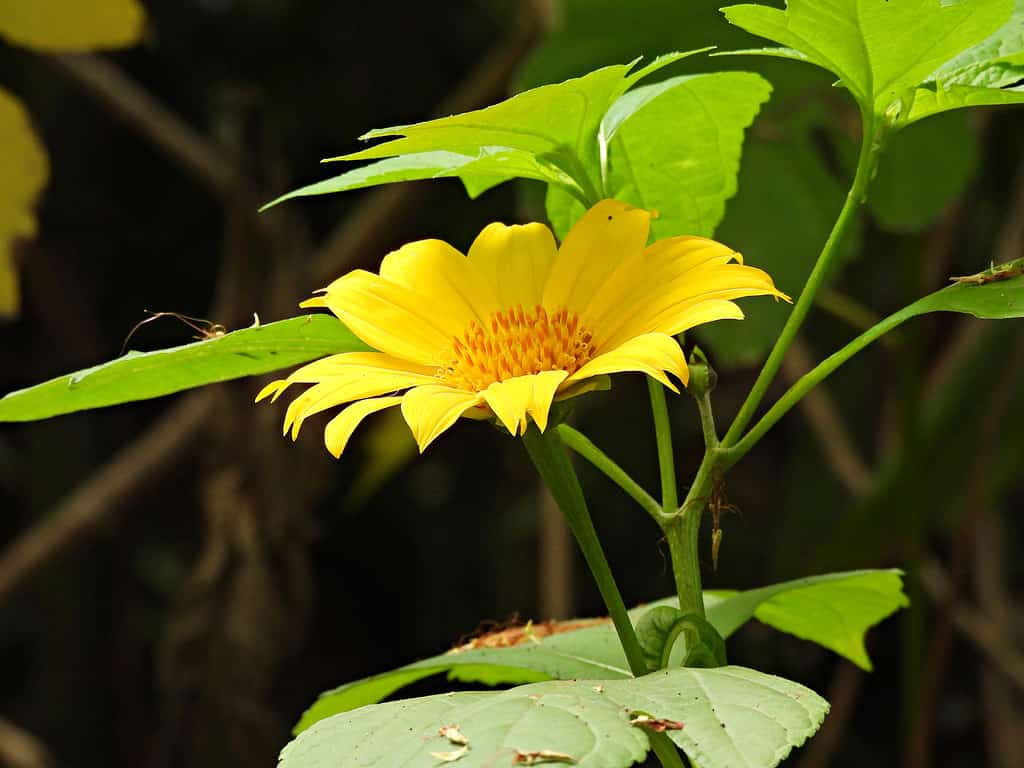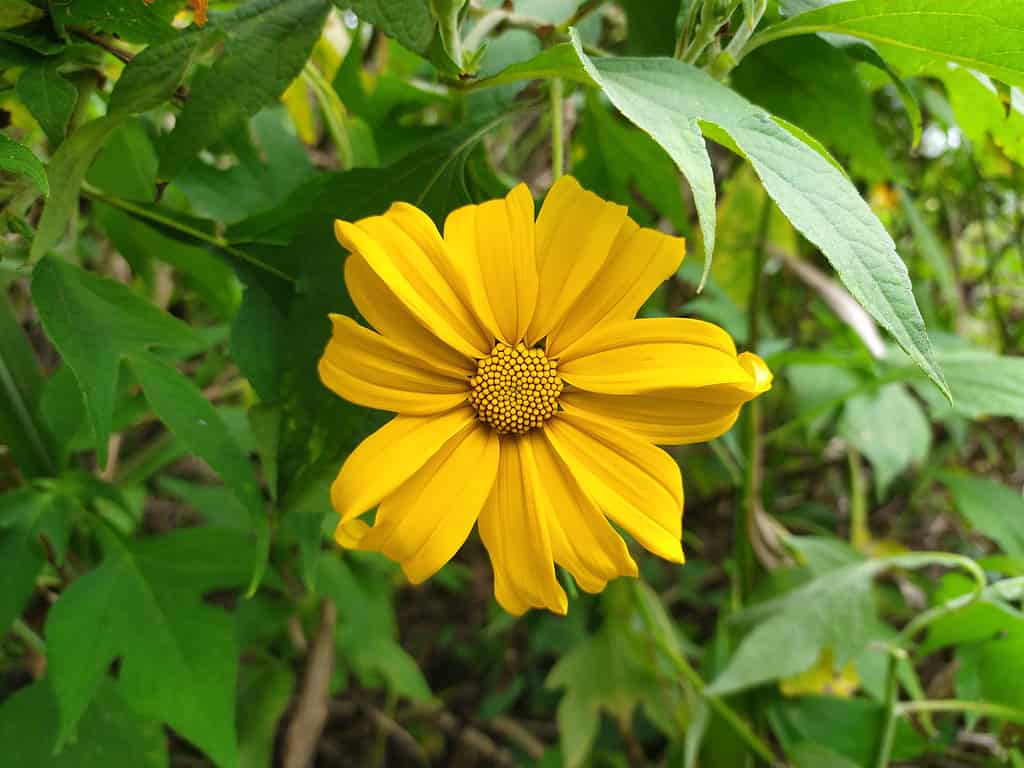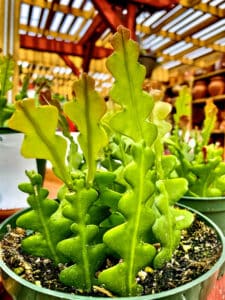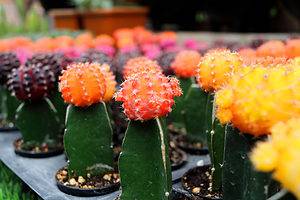Like heavenly bamboo, the Mexican sunflower is the subject of contention among gardeners. While many love it for its vibrant blooms and general ease of care, others regret ever introducing it into their local environment. Don’t necessarily let its mixed reputation precede it, though. With good consideration, this low-maintenance flower powerhouse may be a good fit for your garden.
In this article, we’ll look at the basic characteristics of the Mexican sunflower. We’ll find out where it’s from, what it looks like, and why it is a popular ornamental flower. Additionally, we’ll look at a few of the cultivars available on the market and find out what it takes to grow them at home.
| Botanical Name | Tithonia rotundiflora; Tithonia diversiflora |
| Common Name(s) | Mexican sunflower, tree marigold, tithonia |
| Sunlight | Full sun. 6–8+ hours per day. |
| Water | Low water demand. Prefers drier soil. |
| Soil Conditions | Well-draining, nutrient poor soils are ideal. |
| Hardiness | Grown as annual in all zones. May overwinter in zones 10 and 11. May self seed. |
| Special Considerations | Tithonia diversiflora is considered invasive in some locations for its ability to self-seed and escape cultivation. Take care if planting. |
About the Mexican Sunflower
Two plant species share the common name Mexican sunflower: Tithonia rotundifolia and Tithonia diversifolia. Both are tough, vigorous members of the daisy family (Asteraceae) that are native to Mexico and Central America. They relish the bright sun and hot summer weather, easily enduring dry, nutrient-poor areas where other plants might struggle.
While gardeners across the United States may plant either species for their bright and plentiful summer blooms, those in the southern areas of the country may find them invasive. Tithonia diversifolia in particular readily escapes cultivation, spreading rapidly and aggressively into local environments. The state of Florida, alongside several countries in Africa and southern Asia, considers the plant highly invasive. Additionally, the ability of both species to colonize new areas is predicted to rise alongside temperatures due to accelerating climate change.
The Mexican sunflower’s ability to spread into disturbed regions may not be a bad thing, however. These species are well adapted to respond to the environmental disturbances that accompany expanding urban and suburban developments. As native species collapse under the pressures of expansion and a changing climate, the species that we consider invasive today may be the pioneers of new ecosystems moving forward.

In the right conditions, the Mexican sunflower readily self-seeds and spreads quickly.
©Peera_Sathawirawong/iStock via Getty Images
Physical Characteristics
This species is mostly popular among flower gardeners for its vibrant blooms which appear copiously throughout the late spring and summer. Though Mexican sunflowers are quite different from Helianthus sunflowers, they do have the same complex flower structure. Their large, striking flower heads are not single flowers, but rather large composite flowers made up of numerous smaller ones. At the center of each bloom is a disc comprising many tiny florets, each of which has its own reproductive structures. When pollinated, they give way to the seeds that fill the bloom’s center.
Each of the “petals” that surrounds the central flower disc is actually its own individual floret. Though they are sterile and have no reproductive structures, their vibrant color and “landing pad” shape do help the plant attract pollinators of all kinds to its fertile center.
The rest of the plant is just as beautiful as the flowers. Its bright green leaves may alternate between being lobed and unlobed, even on the same plant, contributing great background texture to the garden. The thin, upright stems are covered in short hairs down their entire length, giving them a soft, glowing appearance.

produces composite flowers. While the ray florets on the outer ring may resemble petals, they are actually independent flowers just like the many disc florets in the center.
©tonsound/iStock via Getty Images
In Cultivation
The plant’s bright, eye-catching blooms and tall, bushy stature make it a great backdrop plant in the garden. It will usually grow as a perennial in USDA zones 10 and above. It grows as an annual in areas where temperatures drop in the fall and winter but can self-seed and reappear the following spring. These flowers are a great source of nutritive plant matter for your garden. As the plants begin to die back in the fall, cut down the aerial parts and leave them in place or mix them into your compost pile for next season.
Surprisingly, there are only a few cultivars of Mexican sunflowers available on the market. The most common one, ‘Torch’ won an AAS award in 1951 for its large, 3″ blooms in fiery shades of orange. The cultivar is available in a yellower form as well, aptly named ‘Torch Yellow’.
You’re also likely to find shorter varieties like ‘Goldfinger’ and ‘Fiesta del Sol”, which received an AAS award as well in 2000. These varieties sacrifice nothing in terms of beauty for the increased versatility their smaller size offers in the garden. If you’re tight on space, these are your go-to Mexican sunflower cultivars.

There are a few available cultivars of the Mexican sunflower, whose colors range from bright yellow to deep orange and burgundy.
©passion4nature/iStock via Getty Images
How to Care for Mexican Sunflowers
For the incredible pop of color they add to the garden, Mexican sunflowers are very easy to care for. There are just a few simple things to keep in mind when caring for them and deciding their position in your layout. The basic care guidelines below will get you off to a great start and help you ensure that your Mexican sunflowers hit their stride.
Sunlight
These flowers love heat and bright sun. They need 6–8 hours of direct sun per day to thrive and produce the greatest quantity of blooms. Planting Mexican sunflowers in an area that receives too little sunlight over the course of the day can cause them to become leggy. If your plants look like they want to flop over, you may need to stake them to give them additional support.
Wherever you plant your flowers, remember that their position in the garden affects more than just their own access to sunlight. As some Mexican sunflower varieties can grow up to 6 feet tall, they can easily shade out other, shorter flowers and shrubs. Many gardeners plant them in the backdrop where they can block out unsightly fencing or create seasonal privacy without disturbing other plants.
Sometimes, their strong ability to shade other plants is beneficial. With attention to layout, Mexican sunflowers can perform well in the center of a circular bed or on the south side of a keyhole garden. There, they can provide temporary shelter to more sensitive plants as the sun reaches peak intensity.

To get the most blooms out of your Mexican sunflowers, be sure they get at least 6–8 hours per day of full sun.
©Doikanoy/Shutterstock.com
Water
These flowers are great for southwest flower gardeners who may otherwise struggle to find climate-appropriate plants. They can handle the hot desert summers and relish the dry air.
While Mexican sunflowers are very drought tolerant and enjoy dry soils, however, they do appreciate moderate soil moisture and regular water when available. Just be careful to let the soil dry out in between waterings, as these plants are sensitive to wet soil conditions. Waterlogging your flowers limits the oxygen their roots receive and creates conditions that are prime for Phytophthora root rot. Signs of overwatering include limp or yellow leaves, floppy stems, shallow roots, stunted growth, or even death. If your flowers are showing any of these signs, it’s best to step back and assess your placement or care routine. If your area is naturally prone to wet soil or poor drainage, you may need to better tailor your approach.
Soil Conditions
Mexican sunflowers thrive in a variety of soil structures as long as they are well-draining. They have adapted to nutrient-poor environments, however, and may struggle to compete with other plants in soils that are overly rich. It’s usually best to fertilize them sparingly or not at all, especially if you allow your annuals to die in place each year. As last year’s plants break down, they return to the soil many of the nutrients they gathered during the previous growing season. They also feed your garden’s microbial population, which is responsible for converting soil nutrients into forms your plants can easily use.
Even if your soil doesn’t drain particularly well, you can likely create a hospitable environment for this plant with a few amendments. You probably already know that sandy soils are very good at draining, but mixing sand into heavy soil is impractical at best. At its worst, it can give a concrete-like structure to the soil, worsening the drainage problem. The best way to amend slow-draining soils is to add organic matter like rotted compost or clean hardwood chips. These materials break up clay particles and increase the soil’s pore size, allowing water to move through more easily. They also absorb and retain a lot of water, increasing the length of time your plants can go in between watering. Mix organic matter into your sunflower’s soil during planting and apply it in thin layers on the soil surface.
Encouraging Blooms
If you meet its pretty simple care requirements, your plant should bloom profusely and continuously all summer long. You can encourage even the happiest plant to produce more blooms, however, by deadheading, or removing spent blooms as they begin to wilt. This practice prevents the plant from expending energy on seed production and instead encourages it to try again, producing more flowers.

©Arif Budiman/iStock via Getty Images
Common Problems
The most common problem that gardeners tend to face when growing Mexican sunflowers is overwatering. Check on your plants in between watering and make sure you allow plenty of time for the soil to dry out. The time it takes for this to happen depends on your local climate and the structure of your garden’s soil. With good attention to soil moisture, caring for Mexican sunflowers is a snap.
In line with the rest of its low-maintenance characteristics, the Mexican sunflower isn’t particularly susceptible to many pests or diseases. When humidity is too high, foliage remains damp, or airflow is limited, powdery mildew may become a problem. This fungal infection presents as white, powdery patches on leaves and buds that eventually produce tiny fruiting bodies. While the condition isn’t always serious, it can cause irregular leaf growth, chlorosis, and flower bud death if left unmanaged. Avoid it by positioning your sunflowers in adequate sun and ensuring good spacing when planting.
Keep an eye out for snails, slugs, or other moisture-loving pests on your flowers after periods of prolonged rain. If you find any of these, you can simply remove and relocate them. These plants are quite hardy and you’re likely to get through the season without too much trouble from insect pests.
Thank you for reading! Have some feedback for us? Contact the AZ Animals editorial team.








